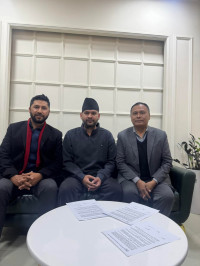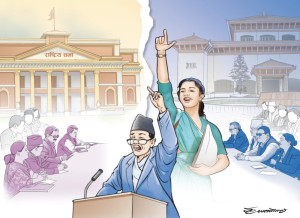Columns
Can small donors support research?
Knowledge-generating entities should create an endowment fund to sustain themselves.
Pratyoush Onta
The financial challenges facing knowledge-generating non-profit independent entities have been a subject of public discussion in Nepal for over two decades. For the most part, these entities are legally registered as non-governmental organisations (NGOs). Some of the more active ones run reading seminars, edit and publish journals, organise workshops/conferences, and do other academic activities; but they rarely run full-time formal degree granting programmes. Hence, although they are an important part of the research landscape in the country, they do not enjoy the status of a college or university and thus remain ineligible for funds disbursed by the country’s University Grants Commission.
Ideally, such knowledge-generating non-profit independent entities that work in the domains of the social sciences should be supported by something like a Nepali Social Science Research Council. In two previous columns (April 28 and May 12, 2023), I have argued that such an autonomous public body should be created, one supported by government-disbursed funds but run by a college of academics who are accountable to their peers at large. Such a council could support a wide variety of knowledge-generating non-profit entities via institutional block grants and theme-specific project grants. However, there is no indication that the Nepal government will establish such a body anytime soon.
Government grants
In the absence of a research supporting council, the government can give grants to specific organisations allowing them to continue to do the activities they are doing. Two years ago, upon the command of the then president of Nepal, Samsodhan Mandal, an organisation that is more than six decades old, got a one-time grant of Rs5 million from the Nepal government (on top of what it had been getting from the Ministry of Education, Science and Technology annually). Given such a precedent, I assume that similar grants could be given to other non-profit research entities on the basis of their ongoing track records. But many such organisations are unlikely to receive such one-time grants since many of them are still beyond the radar of those who hold high offices in the country and their advisors.
International donor support for knowledge-generating non-profit independent organisations is unpredictable, and Nepali corporate philanthropic support for academic work is virtually non-existent. In such a dismal scenario, it seems relevant to advocate an idea that has been mentioned from time to time in Nepal and regularly deployed in other countries. The idea is for such entities to try to create an endowment fund with many donors, each of whom is willing to make small contributions.
Let us first note that there is nothing original about the idea of seeking help from many small donors to support academic work. Almost every degree-granting institution of higher education in the United States has benefited from such small donations. For every known donor who makes the news for a large gift to an American institution of higher learning, there are thousands of other donors who have supported the universities and colleges they attended through small donations consisting of just $10-50. Such contributions might not enlarge the institutional endowments per se, but they help to support these universities and colleges to carry on with their daily work of teaching and training a new generation of thinkers, researchers and professionals. These contributions come in regularly even when buildings and chairs in the concerned institutions don’t get named after the small donors.
Let us return to the Nepali context and do some math. For the sake of this analysis, let us assume that one Nepali knowledge-generating non-profit organisation is hoping to raise an endowment of Rs100 million over the course of five years. This means that the organisation will have to raise an average of Rs20 million during each of those five years. To raise Rs20 million, the organisation has to find exactly 800 individuals who are willing to make an average contribution of Rs25,000 anytime during that year-long period.
Twenty-five thousand is a lot of money for most Nepalis, but surely there are tens of thousands of our citizens in Nepal and abroad who can donate that amount to support academic work in the country. Some might even be able to donate such an amount annually during each of the five years. We must also remember that there is a significant number of videshi colleagues who have built careers based on Nepal-related research who might be called upon to also provide small contributions. And there is an even larger number of Nepal-loving foreign friends who might similarly be expected to help.
Creating an endowment of Rs100 million with the help of many small donors will involve many transactions, both financial and non-financial. The latter would include digital and in-person communications of various types so that the potential small donors are convinced that the scheme they are contributing to is a sound one. It will also need a sustained effort on the part of those affiliated with the organisation in question. Strategically, I assume the initial set of people to approach would be those that have benefited from the organisation’s work—directly or indirectly—in the past and are now financially comfortable to make the kind of donation discussed here.
Pious donors
Other initial donors to approach would be those who understand the value of social science research for a loktantrik polity and are willing to contribute towards making that possible in Nepal. Subsequent sets of potential small donors might need a lot more persuasion, but if the organisation has a good track record—both in terms of its work outputs and its governance mechanism—this should be possible. Once the endowment reaches Rs100 million, its interest income can be used to support the core work of the organisation even as it looks for project funds elsewhere.
Finally, we should also note that while its use in the academic domain in Nepal is new, the underlying mechanism regarding the coming together of small donors to realise a common goal has been at play in our country for a long time. The plaques that can be found in many temple complexes all over the country that list the names of small donors who have contributed to the repairs of the concerned temple are proof of this mechanism at work. Similarly, small donors have contributed in the construction of libraries, school buildings and health posts in various parts of Nepal. We now need to make this happen for academic research even as we appeal to the Nepal government to increase its support for research by Nepali organisations through the founding of a Nepali Social Science Research Council.




 5.4°C Kathmandu
5.4°C Kathmandu













%20(1).jpg&w=300&height=200)

